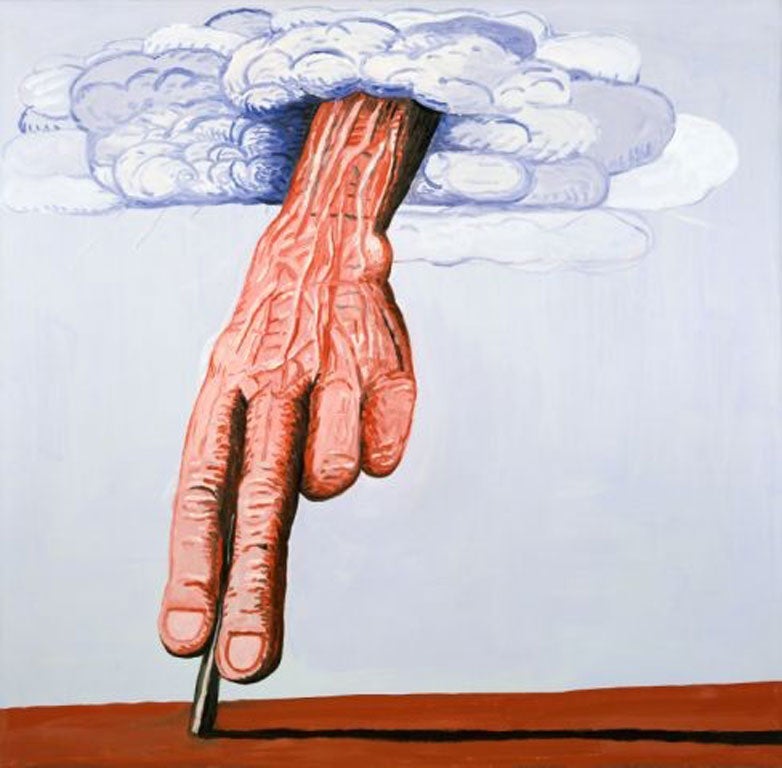When fingers point
Philip Guston's switch from abstract to figurative left critics and fans irate, but an exhibition of his work proves them wrong, argues Adrian Hamilton

In 1967, after a two-year absence from painting and at the age of 54, one of America's leading abstract expressionists, Philip Guston, shocked the art world and disgusted his fans by an abrupt return to figuration. Not only that, the figurative art he produced was of a crude, cartoon-like quality that seemed to belie all the emotional intensity and purity of his abstract work. Like Bob Dylan embracing rock, Guston's sudden change of course was regarded not just an aberration, but a betrayal of principle, beliefs and modernism. Yet today his so-called "late" paintings are regarded, not just as a developmental part of the output of one of the major figures of the post-war American scene, but among his finest paintings and been hailed as masterpieces.
You can decide yourself which side you take in a brilliant show at Inverleith House in Edinburgh.
What makes them so compulsive? Even today you can see why his contemporaries and supporters were so appalled by Guston's new turn. The characters are childlike. The imagery of Ku Klux Klan hoods, cigars and cyclopic eyes is crude. The palette is limited to the colours of flesh and earth, pink, ochre and greys. The brushwork is broad to the point of slapdash. And yet you are drawn in to the conversation of an artist talking to himself and then looking up at you with an ironic and despairing grin. Part of the compulsion comes from the outrageous courage of the enterprise. Just as Guston put himself and his emotion into abstract expressionism, so he is giving you himself in the figurative paintings. They are not naïve. Although largely self-taught, Guston had all the learning of the auto-didact, with a broad knowledge of art, especially the Italian masters as well as the surrealists. The best-known painting on display, The Line, takes Michelangelo's image of God's fingertip act of creation and gives it to you face-on as the hand of the artist inscribing a line with a piece of charcoal held between two monumental fingers. The symbolism is obvious but the power, along with the humanity, comes from the veins pressing down along the hand against a light-blue pastel background that seems to highlight their rawness.
An early vision of The City (1969) takes the image of Babel and Babylon from Flemish Renaissance and painting but gives it a soullessness, as the pink buildings with their black dashes for windows replicate themselves on and on into the horizon. In a remarkable early picture, Black Sea (1977), a solid shape imposes itself on the dark waters, emphatically there but ambiguously imaged. It is this deliberate counter-point between ambition and self-effacement; between solid mass and soft colour; between knowingness and innocence, that makes Guston's work so intriguing. You can elaborate an awful lot of interpretations from his imagery, talk of his "language" and "alphabet" as curators do. But then the artist himself looks at you with an ironic smile and a shrug of self-deprecation. The angst is real, very real. Guston's father committed suicide in full view of his small son and his brother died of gangrene after being run over by his own car. In his own act of denial, he had changed his name from Goldstein to Guston to disguise his Jewishness. This is the art, like that of Edvard Munch, of a man who has not resolved his demons but is determined to release them in paint.
In the most important and self-defining work in the exhibition, The Studio (1969), the artist in trademark hood paints himself at work in the manner of Velazquez, Rembrandt and the great masters. The hands are gigantic, one holds a cigar between two fingers, the other the paintbrush. The clock on the wall only has one hand, the self-portrait starts with the seams of the hood not its outline. The smoke appears to be coming from the paintbrush not the cigar. The whole scene is illuminated by a lightbulb, an image of interrogation, while a splash of green marks the blind of a window that appears to cast no light. It's at once jovial and disconcerting.
David Hockney, at least, should approve of the frequent insertion of the cigarette and cigar. It appears in an oddly squidgy portrait of himself lying smoking on his bed in Smoking I (1973) and, more aggressively in Riding Around (1969), which sees three hooded figures driving in an open-topped car, the two on the outside holding cigarettes, the figure in between pointing forward. The grey tobacco smoke puffs up against the white clouds, making them an intrusive and threatening presence. Guston had started as a social realist and never lost his sense of political anger. The Meeting (1969) introduces the hooded KKK figures, the naked lightbulb and the window with the blind as symbols of fear and alienation. They, like the cigarette, keep reappearing in his later works.
You can view the return to the childlike, as in late Picasso, as a desire to find the root of art and the most basic expression of feeling. But the irony and self-mocking have an edge all of their own. Not comfortable viewing but hypnotic.
Join our commenting forum
Join thought-provoking conversations, follow other Independent readers and see their replies
Comments
Bookmark popover
Removed from bookmarks